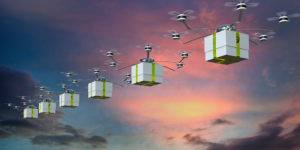No Temperature Controls Necessary For Small Molecules? Are You Sure?
Ensuring Quality for Small Molecule Therapy Supply Chains in a Growing Market Managing the...
read Details

Today drug product delivery via drone is no longer a fringe technology – it’s here to stay. Over the past decade, drones have been the subject of experiment for use in broadening the capability of supply chain professionals to deliver life-saving vaccines and temperature sensitive drug therapies. (1) Drones are transforming the pharmaceutical supply chain transportation model at a swift tempo, enabling the safe delivery of life-saving vaccines and medical supplies to areas impacted by natural disaster or an epidemic outbreak in record time, where poor infrastructure and instability can limit patient access. (2) The impact of this new technology on the supply chain industry, including the biopharmaceutical cold chain, is monumental.
However, the innovation and implementation of drone technology are outpacing international aviation regulatory bodies ability to enact current oversight. (3) NASA has taken the first step in attempting to develop a protocol, but determining and enforcing the rules is in the jurisdiction of the FAA. (4) The FAA released recent drone-related regulations in 2016 (Small UAS Rule – Part 107). Unfortunately, Part 107 does not address regulations specific to drone delivery, nor does it define rules for pilotless flight. (1) The regulations include operational limitations for drones, including specifying maximum weight (25 kg), flight altitude (400 ft), and a stipulation that they may be operated only during daylight hours. The constraint raising the largest barricade to unleash the potential of drones is the requirement to maintain the visual line of sight (VLOS), preventing UAVs from performing long-distance tasks outside the sight of an observer. (1)
Adopting drone delivery technology will open new markets and service areas previously considered not cost effective or too risky, such as engagement in humanitarian logistics, emergency, and disaster response. Drone delivery can speed up laboratory test results, blood supply, and organ transplant shipping and service to rural areas around the world previously thought unmanageable. Integrating drone technology fortifies your existing supply chain and widens your access to a larger patient population. Using drones to deliver drug products causes a paradigm shift from operating within a predictive model to operating within a responsive model of drug delivery logistics, especially for the last mile delivery to the patient.(7)
General benefits of drone delivery include:
The future of drone deliveries may lie in the hands of regulators. Less crowded air space and fewer regulations are ideal for successful drone delivery implementations. Zipline’s success story in a less developed country with challenging geography is a good example. California – based Zipline has built the swiftest and reliable delivery drone, capable of reaching speeds of up to 100 kilometers per hour, for the biopharmaceutical supply chain for humanitarian outreach. Motivated by suboptimal logistics infrastructure and rudimentary, vulnerable, and expensive drug product storage facilities in Rwanda, Zipline recognized an opportunity to improve the delivery of life-saving blood. They responded to the challenge by organizing a project with UPS and GAVI to collaboratively establish and test a drone delivery program.
The project team fabricated launch and landing stations capable of transporting up to 150 emergency deliveries per day to 21 transfusing stations in the western region of the country. Upon receipt of an order for blood, the orders were immediately packaged and sent to the patient. With flying at over 100 kilometers per hour, the life-saving blood and medical supplies are delivered within thirty minutes to the patient from the sky via parachute, which was once a 5-hour round-trip truck drive. (6) Zipline accredits the speed of their drones to their ability to maintain a proper cold chain network.
Early public acceptance of drone delivery networks in urban areas will revolve around hospitals. And once drones can safely and reliably carry blood and medical supplies, that will pave the way to other kinds of drone deliveries. (9) Last October Swiss Post launched a medical transport network in Lugano, Switzerland, using drones made by another Bay Area company, Matternet. So far, the drones have made 350 deliveries, about 5 to 15 per day. (9)
In the US, Matternet is partnering with the city of Palo Alto on a proposal to shuttle blood to Stanford hospitals. Flirtey, a drone manufacturer in Reno, NV is focusing on using its aircraft for last-mile delivery of defibrillators — devices the company thinks could save hundreds of thousands of lives in America each year, by increasing the chance of survival from out-of-hospital cardiac arrest. (9) Beyond the blood and medical supply deliveries, drones could transform another key component of healthcare — lab tests. Timely test results help doctors diagnose infections and reduce guesswork in prescribing medications. Some of those decisions have life-or-death implications.(9)
Globally, last summer, UNICEF worked with local governments in the African country of Malawi to launch a drone corridor for companies, universities, and nonprofits to fly test missions there. UNICEF also invited groups to transport vaccines in Vanuatu, the South Pacific nation made up of roughly 80 islands east of Australia. The drone corridors run on a barter system, says Chris Fabian, who leads UNICEF’s venture capital arm. (13)
Modality Solutions has extensive hands-on experience managing cold chain logistics hurdles and validating a supply chain in a Zone IV ICH stability zone with its own set of unique challenges not faced by typical supply chains. Primarily, the availability of resources needed to make a shipment as documented in the validation master plan. A refrigerated truck, dry ice, or even a basic polystyrene shipper available one day might not be available the next. Creating standard operating procedures by itself becomes a challenge because there are few things about the supply chain that are standard. Supply chains in these areas are most successful when they are most adaptable. When they have many different options to compensate for when one is not available.
In addition, many areas in these zones have additional hurdles like underdeveloped infrastructure, making it difficult to even get from one location to another. When there are only dirt roads going through a thick brush or arid desert, the supply chain depends on that road being traversable on that day. If it is blocked for whatever reason, there often is no other option. In these areas, there are wet seasons of the year during which the roads are nearly impossible to traverse. In these cases, locals sometimes favor delivering via motorcycle courier instead of a truck because they can drive on the mud roads.
Modality Solutions has experience managing clinical trials for candidate vaccines and treatments for the Ebola virus throughout Western Africa. We are very knowledgeable of the challenges of delivering cold chain therapies in Zone III and IV ICH stability zones. Every member of our team works to maximize clinical trial performance, data integrity, and patient safety. Our cold chain and engineering expertise enabled our in-country, “boots on the ground” team of engineers, project managers, and principals to develop procedures adapted to the specific materials, equipment, and transportation capabilities unique to Western Africa.
Furthermore, the development of these procedures required personnel to travel to relevant facilities and ensure that the requirements of the SOPs were not exceeding the capabilities of equipment and personnel at each site. Our team trained local staff on the SOPs to determine whether the procedures aligned with site capability.
We are the experts in challenging cold chain clinical trial monitoring and logistics and provide operational and technical support to the Ebola vaccination project in Sierra Leone, as well as providing assessments of multiple sites for the NIH vaccine projects in the Caribbean. We understand the challenges faced by health care staff in underdeveloped areas of the world and always maintain a presence throughout the duration of a project, staying close until we know the job is done. Modality Solutions is familiar with the challenges and has the experience and resources to take any existing supply chain logistics plan, validate and integrate it for drone delivery applications.
Completing an operational qualification for an airborne drone presents additional challenges in operational qualification (OQ) and performance qualification (PQ):
New drug delivery technology requires supply chains to be proactive rather than reactive. Predictive analytics leverage historical and current performance data in order to make predictions on future performance, creating intelligent supply chains capable of swift adaptation and agile decision-making processes, as it is no longer adequate to react to issues after the fact – we must anticipate future performance in order to make intelligent decisions. (8) Cargo drones promise to make systems responsive rather than predictive. (8) With our novel technologies, a proven track record of successful collaborations enabling over 75 new drug approvals, and access to industry influencers, we are prepared to transform your drug delivery operations to a predictive, agile, integrated cold chain.
There are several areas of impact specific to cold chain logistics to consider before integrating drone delivery with your current operations. Updating your Validation Master Plan using these guidelines will give you a head start:
The decisions you make regarding cold chain operations can make life-saving drugs potentially deadly if the cold chain is disrupted. (8) Avoid failures in infrastructure, decision making, coordination, and planning by partnering with the experts at Modality Solutions. With our Advantage Transport Simulation Laboratory™, a proven track record of successful collaborations enabling over 75 new drug approvals, expertise in Validation Master Planning, and access to industry influencers, we are prepared to transform your drug delivery operations to a predictive, agile, integrated cold chain for drone delivery system.
Expertise in Biopharmaceutical Cold Chain Management Systems Leads to Regulatory Compliance and Consistent Process Controls.
References
1. Lin, Pharm. D, Connie A, et al. Drone delivery of medications: Review of the landscape and legal considerations. American Journal of Health-System Pharmacy. 2018, Vol. 75, 3, pp. 153–158.
2. Pharma Logistics IQ. What is drone delivery, and how is it changing the pharmaceutical supply chain? Pharma Logistics IQ. [Online] April 12, 2019. [Cited: June 18, 2019.] https://www.pharmalogisticsiq.com/logistics/articles/what-is-drone-delivery-and-how-is-it-changing-the-pharmaceutical-supply-chain.
3. Heck, Andrew J. and McClanahan, Christopher J. Safety Concerns Prompt New FAA Regulations for Drones. The National Law Review. [Online] April 18, 2019. [Cited: June 17, 2019.] https://www.natlawreview.com/article/safety-concerns-prompt-new-faa-regulations-drones.
4. NASA. FAQs: NASA’s Drone Traffic Management Research in Reno and Corpus Christi. www.nasa.gov. [Online] May 28, 2019. [Cited: June 17, 2019.] https://www.nasa.gov/feature/ames/faqs-nasa-s-drone-traffic-management-research-in-reno-and-corpus-christi.
5. Connolly, Kate Bertrand. Eyes on the Skies: The Dream of Drone Delivery Starts to Take Flight. [ed.] Lisa McTigue Pierce, Daphne Allen and Rick Lingle. Packaging Digest. 2016, Vol. 53, 3.
6. Zipline. zipline. [Online] [Cited: June 18, 2019.] https://flyzipline.com/impact/.
7. Stefanovic, Nevad. Proactive Supply Chain Performance Management with Predictive Analytics. The Scientific World Journal. [Online] October 15, 2014. [Cited: June 18, 2019.] https://www.ncbi.nlm.nih.gov/pmc/articles/PMC4214046/.
8. Morain, Tony. Direct Relief, Merck and Partners Test Temperature-Controlled Autonomous Drone Delivery System for Medicines in Puerto Rico. www.directrelief.org. [Online] August 24, 2018. [Cited: June 18, 2019.] Researchers estimate that most deaths from Hurricane Maria in September 2017, were caused by loss of access to medicines and health care, not by wind or water. As people were displaced from their homes, health centers lost power for weeks, and travel was.
9. LANDHUIS, Esther. Medical Cargo Could Be The Gateway For Routine Drone Deliveries, March 10, 2018, 9:01 AM radio broadcast[cited: July 01, 2019] https://www.npr.org/sections/health-shots/2018/03/10/592059175/medical-cargo-could-be-the-gateway-for-routine-drone-deliveries
Ensuring Quality for Small Molecule Therapy Supply Chains in a Growing Market Managing the...
read Details
Ensuring the safe, effective delivery of small molecule drugs is more challenging than ever....
read Details
At a Glance: Cold Chain Engineering: Modality Solutions focuses on enhancing drug delivery through...
read Details